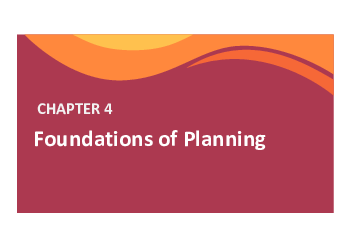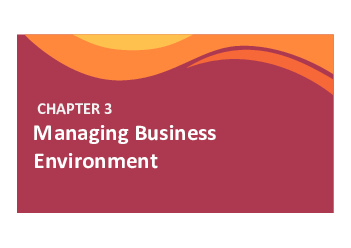

































Preview text:
lOMoARcPSD|36041561 CHAPTER 6 Organizing
Downloaded by Nga T??ng (ngahuong55@gmail.com) lOMoARcPSD|36041561 : work specialization,
departmentalization, chain of command,
span of control, amount of centralization Learning Outcomes
decentralization, and amount of formalization. D
ü Describe six key elements in organizational design.
ü Contrast mechanistic and organic structures.
ü Discuss the contingency factors that favor either the
mechanistic model or the organic model of organizational design.
ü Describe traditional organizational designs.
ü Describe modern organizational designs.
Downloaded by Nga T??ng (ngahuong55@gmail.com) lOMoARcPSD|36041561
6.1 Designing Organizational Structure
6.1.1 What Is Organizational Structure?
ü Organizing - arranging and structuring work to
allocating, ultilizing resources
accomplish an organization’s goals.
ü Organizational Structure - the formal arrangement of jobs within an organization.
ü Organizational chart - the visual representation of an organization’s structure.
Downloaded by Nga T??ng (ngahuong55@gmail.com) lOMoARcPSD|36041561
Downloaded by Nga T??ng (ngahuong55@gmail.com) lOMoARcPSD|36041561
6.1 Designing Organizational Structure
6.1.2 Purposes of Organizing
ü Divides work to be done into specific jobs and departments.
ü Establishes formal lines of authority.
ü Establishes relationships among individuals, groups, and departments. ü Clusters jobs into units.
ü Coordinates diverse organizational tasks.
ü Assigns tasks and responsibilities associated with individual jobs.
ü Allocates and deploys organizational resources.
Downloaded by Nga T??ng (ngahuong55@gmail.com) lOMoARcPSD|36041561 ARRANGING + ASSIGNING + ALLOCATING = ORGANIZING
Downloaded by Nga T??ng (ngahuong55@gmail.com) lOMoARcPSD|36041561
6.1 Designing Organizational Structure
6.1.3 Organizational Design ü Work specialization ü Departmentalization ü Chain of command ü Span of control
ü Centralization and decentralization ü Formalization
Downloaded by Nga T??ng (ngahuong55@gmail.com) lOMoARcPSD|36041561
6.1.3 Organizational Design a. Work specialization
ØDividing work activities into separate job tasks.
ØEarly proponents of work specialization believed it
could lead to great increases in productivity. ØOverspecialization can result in human
diseconomies such as boredom, fatigue, stress,
poor quality, increased absenteeism, and higher turnover.
Downloaded by Nga T??ng (ngahuong55@gmail.com) lOMoARcPSD|36041561
Economies and Diseconomies of Work Specialization Overspecialization: Divided
into too small job tasks => Loose motivation, stress
Downloaded by Nga T??ng (ngahuong55@gmail.com) lOMoARcPSD|36041561
6.1.3 Organizational Design b. Departmentalization - the basis by which jobs are grouped together • Functional • Process – Grouping jobs by functions
– Grouping jobs on the basis • Product of product or customer flow – Grouping jobs by product • Customer line – Grouping jobs by type of • Geographical customer and needs
– Grouping jobs on the basis of territory or geography
Downloaded by Nga T??ng (ngahuong55@gmail.com) lOMoARcPSD|36041561
Common Forms of Departmentalization
Downloaded by Nga T??ng (ngahuong55@gmail.com) lOMoARcPSD|36041561
Common Forms of Departmentalization
Downloaded by Nga T??ng (ngahuong55@gmail.com) lOMoARcPSD|36041561
Common Forms of Departmentalization
Downloaded by Nga T??ng (ngahuong55@gmail.com) lOMoARcPSD|36041561
Departmentalization Trends
Ø Increasing use of customer departmentalization.
Ø Cross-functional team - a work team composed of
individuals from various functional specialties.
Downloaded by Nga T??ng (ngahuong55@gmail.com) lOMoARcPSD|36041561
6.1.3 Organizational Design c. Chain of Command
The continuous line of authority that extends from upper
levels of an organization to the lowest levels of the
organization - clarifies who reports to whom.
Downloaded by Nga T??ng (ngahuong55@gmail.com) lOMoARcPSD|36041561
6.1.3 Organizational Design Authority
ü Authority - the rights inherent in a managerial position to tell
people what to do and to expect them to do it.
ü Acceptance theory of authority - the view that authority
comes from the willingness of subordinates to accept it.
ü Line authority - authority that entitles a manager to direct the work of an employee.
ü Staff authority - positions with some authority that have
been created to support, assist, and advise those holding line authority.
Downloaded by Nga T??ng (ngahuong55@gmail.com) lOMoARcPSD|36041561
Chain of Command and Line Authority
Downloaded by Nga T??ng (ngahuong55@gmail.com) lOMoARcPSD|36041561
Line Versus Staff Authority
Downloaded by Nga T??ng (ngahuong55@gmail.com) lOMoARcPSD|36041561
6.1.3 Organizational Design d. Span of Control
The number of employees who can be effectively and
efficiently supervised by a manager.
Downloaded by Nga T??ng (ngahuong55@gmail.com) lOMoARcPSD|36041561
6.1.3 Organizational Design
e. Centralization versus Decentralization
ü Centralization - the degree to which decision making is
concentrated at upper levels of the organization.
ü Decentralization - the degree to which lower-level
employees provide input or actually make decisions.
ü Employee empowerment - giving employees more
authority (power) to make decisions.
Downloaded by Nga T??ng (ngahuong55@gmail.com) lOMoARcPSD|36041561
Centralization or Decentralization
Downloaded by Nga T??ng (ngahuong55@gmail.com) lOMoARcPSD|36041561
6.1.3 Organizational Design f. Formalization
ü The degree to which jobs within the organization are
standardized and the extent to which employee behavior is
guided by rules and procedures.
ü Highly formalized jobs offer little discretion over what is to be done.
ü Low formalization means fewer constraints on how employees do their work.
Downloaded by Nga T??ng (ngahuong55@gmail.com) lOMoARcPSD|36041561
6.2 Mechanistic and Organic Structures
ü Mechanistic organization - an organizational design
that’s rigid and tightly controlled. ü Organic organization - an organizational design
that’s highly adaptive and flexible
Downloaded by Nga T??ng (ngahuong55@gmail.com) lOMoARcPSD|36041561
6.3 Factors Affecting Structural Choice
6.3.1 Strategy and Structure
Ø Changes in corporate strategy should lead to changes in an
organization’s structure that support the strategy. Ø Certain structural designs work best with different organizational strategies. +The
organic structure works well for organizations
pursuing meaningful and unique innovations.
+The mechanistic organization works best for companies
wanting to tightly control costs.
Downloaded by Nga T??ng (ngahuong55@gmail.com) lOMoARcPSD|36041561
6.3 Factors Affecting Structural Choice
6.3.2 Size and Structure
As an organization grows larger, its structure tends
to change from organic to mechanistic with increased
specialization, departmentalization, centralization, and rules/regulations.
Downloaded by Nga T??ng (ngahuong55@gmail.com) lOMoARcPSD|36041561
6.3 Factors Affecting Structural Choice
6.3.3 Technology and Structure
Ø Organizations adapt their structures to their technology.
Ø Woodward’s classification of firms based on the
complexity of the technology employed:
+Unit production of single units or small batches.
+Mass production of large batches of output.
+Process production in continuous process of outputs.
Downloaded by Nga T??ng (ngahuong55@gmail.com) lOMoARcPSD|36041561
Woodward’s Findings on Technology and Structure
Downloaded by Nga T??ng (ngahuong55@gmail.com) lOMoARcPSD|36041561
6.3 Factors Affecting Structural Choice
6.3.4 Environmental Uncertainty and Structure
ü Mechanistic organizational structures tend to be
most effective in stable and simple environments.
ü The flexibility of organic organizational structures is better suited for dynamic and complex environments.
Downloaded by Nga T??ng (ngahuong55@gmail.com) lOMoARcPSD|36041561
6.4 Traditional Organizational Designs ü Simple structure
- an organizational design with
low departmentalization, wide spans of control,
centralized authority, and little formalization. ü Functional structure - an organizational design
that groups together similar or related occupational specialties.
ü Divisional structure - an organizational structure
made up of separate, semiautonomous divisions.
Downloaded by Nga T??ng (ngahuong55@gmail.com) lOMoARcPSD|36041561
6.4 Traditional Organizational Designs
Downloaded by Nga T??ng (ngahuong55@gmail.com) lOMoARcPSD|36041561
6.5 Contemporary Organizational Design
ü Team Structure - an organizational structure in which the
entire organization is made up of work teams.
ü Matrix Structure - an organizational structure that assigns
specialists from different functional departments to work on one or more projects.
ü Project Structure - an organizational structure in which
employees continuously work on projects.
ü Boundaryless Structure - an organization whose design
is not defined by, or limited to, the horizontal, vertical, or
external boundaries imposed by a predefined structure
Downloaded by Nga T??ng (ngahuong55@gmail.com) lOMoARcPSD|36041561
Example of a Matrix Organization
Downloaded by Nga T??ng (ngahuong55@gmail.com) lOMoARcPSD|36041561
6.5 Contemporary Organizational Design
Downloaded by Nga T??ng (ngahuong55@gmail.com) lOMoARcPSD|36041561
6.5 Contemporary Organizational Design
Downloaded by Nga T??ng (ngahuong55@gmail.com)


